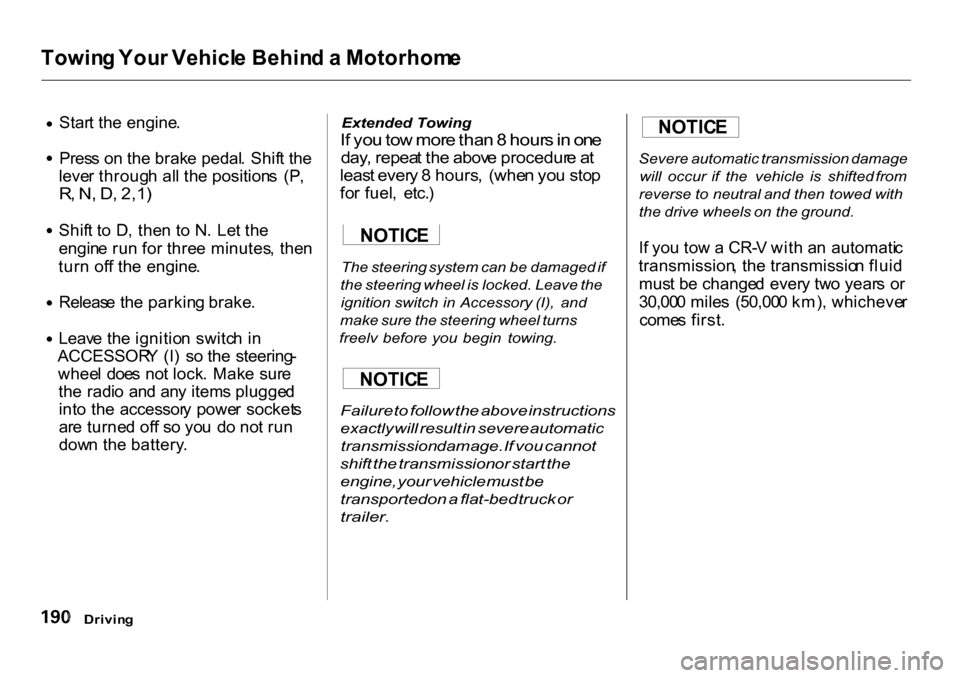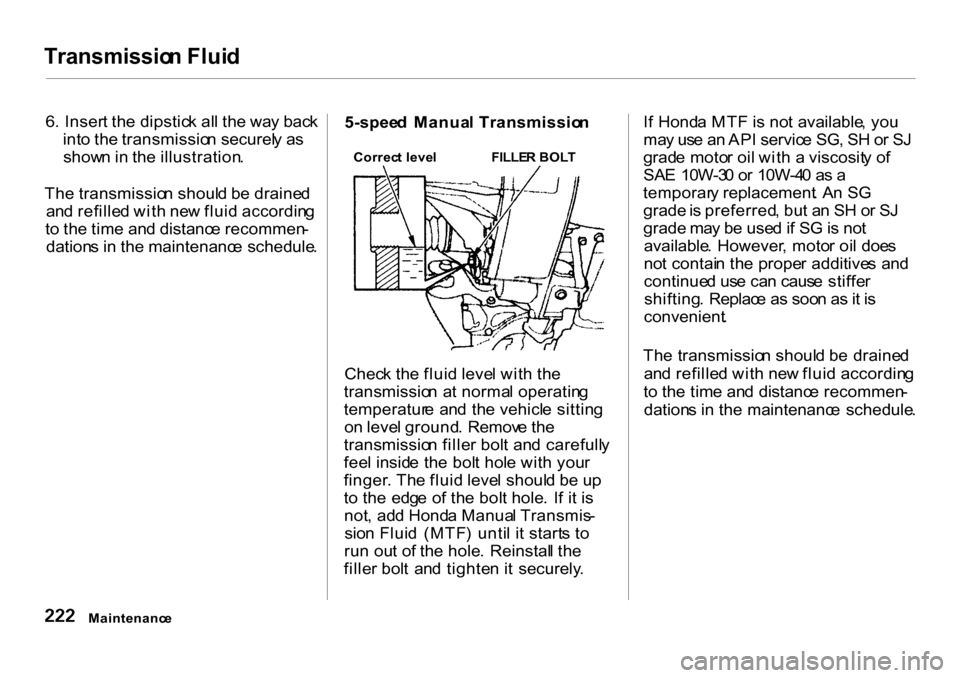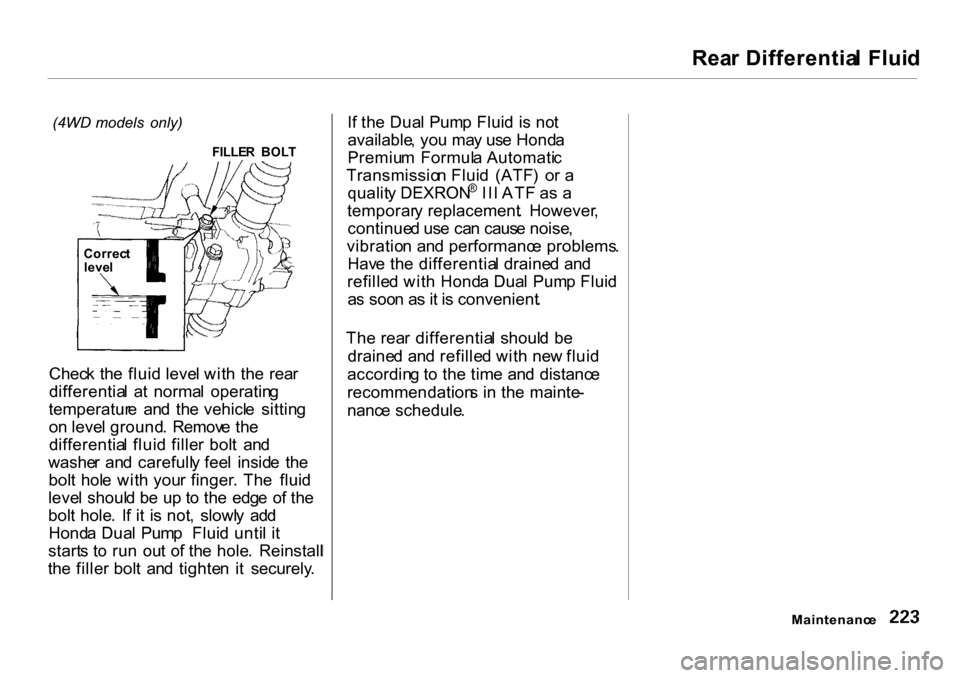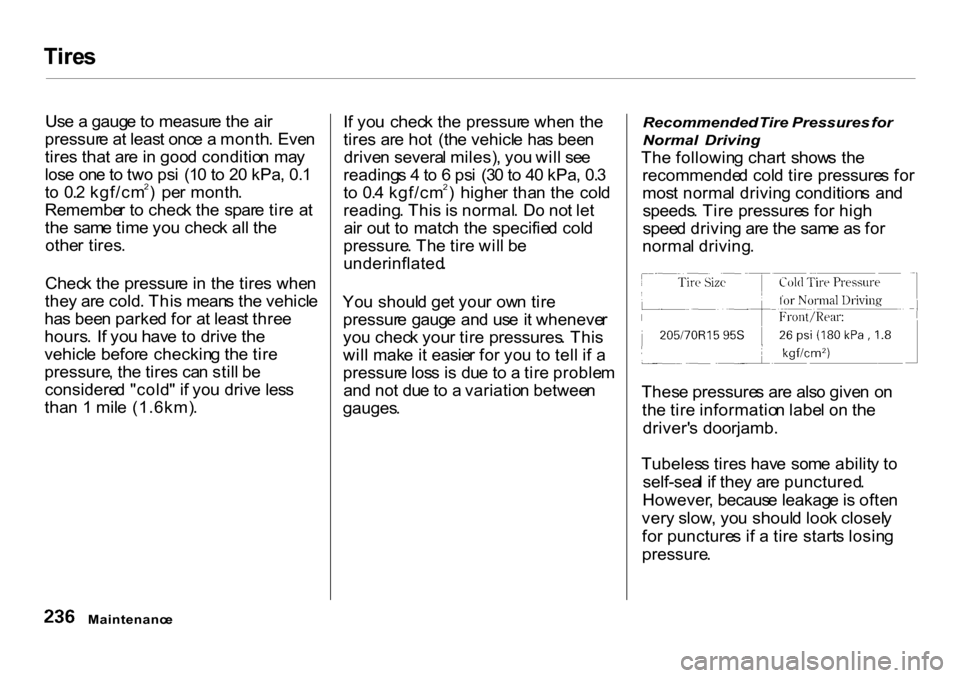Page 171 of 326
Startin
g th e Engin e
Startin g in Col d Weathe r a t Hig h
Altitud e (Abov e 8,00 0 feet /
2,40 0 meters )
A n engin e is harde r t o star t i n col d
weather . Th e thinne r ai r foun d a t
hig h altitud e abov e 8,00 0 fee t (2,40 0
meters ) add s t o th e problem .
Us e th e followin g procedure :
1 . Tur n of f al l electrica l accessorie s
t o reduc e th e drai n o n th e battery .
2 . Pus h th e accelerato r peda l half -
wa y t o th e floo r an d hol d it ther e
whil e startin g th e engine . D o no t
hol d th e ignitio n ke y i n STAR T
(III ) fo r mor e tha n 1 5 seconds .
Whe n th e engin e starts , releas e
th e accelerato r peda l graduall y a s
th e engin e speed s u p an d smooth s
out . 3
. I f th e engin e fail s t o star t i n ste p 2 ,
pus h th e accelerato r peda l t o th e
floo r an d hol d it ther e whil e yo u
tr y t o star t th e engin e fo r n o mor e
tha n 1 5 seconds . I f th e engin e
doe s no t start , retur n to ste p 2 .
Driving
Page 175 of 326
Automati
c Transmissio n
Par k (P ) — Thi s positio n mechani -
call y lock s th e transmission . Us e
Par k wheneve r yo u ar e turnin g of f o r
startin g th e engine . T o shif t ou t o f
Park , yo u mus t pres s o n th e brak e
peda l an d hav e you r foo t of f th e
accelerato r pedal . Pul l th e shif t leve r
toward s you , the n mov e it ou t o f
Park .
I
f yo u hav e clon e al l o f th e abov e an d
stil l canno t mov e th e leve r ou t o f
Park , se e Shif t Loc k Releas e o n pag e
162 .
Yo u mus t als o pul l th e shif t leve r
toward s yo u to shif t int o Park . T o
avoi d transmissio n damage , com e to
a complet e sto p befor e shiftin g int o
Park . Th e shif t leve r mus t b e in Par k
befor e yo u ca n remov e th e ke y fro m
th e ignitio n switch .
Driving
CONTINUED
Page 177 of 326

Automati
c Transmissio n
Whe n th e Over-Driv e i s of f th e
transmissio n select s onl y th e firs t
thre e gears , bu t no t th e fourth . Tur n
th e O/ D of f t o provid e engin e
brakin g whe n goin g dow n a stee p hill .
Yo u ca n als o avoi d th e transmissio n
fro m cyclin g betwee n thir d an d
fourt h gear s i n stop-and-g o driving .Secon
d (2 ) — To shif t t o Second ,
pul l th e shif t leve r toward s you , the n
shif t t o th e lowe r gear . Thi s positio n
lock s th e transmissio n i n secon d
gear . I t doe s no t downshif t t o firs t
gea r whe n yo u com e t o a stop .
Secon d give s yo u mor e powe r whe n
climbing , an d increased engine
brakin g whe n goin g dow n stee p hills .
Us e secon d gea r whe n startin g ou t
o n a slipper y surfac e o r i n dee p snow .
I t wil l hel p reduc e wheelspin .
Firs t (1 ) — To shif t fro m Secon d t o
First , pul l th e shif t leve r toward s you ,
the n shif t t o th e lowe r gear . Wit h th e
leve r i n thi s position , th e transmis -
sio n lock s i n Firs t gear . B y upshift -
in g an d downshiftin g throug h 1 , 2 , D ,
yo u ca n operat e thi s transmissio n
muc h lik e a manua l transmissio n
withou t a clutc h pedal . Engin
e Spee d Limite r
I f yo u excee d th e maximu m spee d
fo r th e gea r yo u ar e in , th e engin e
spee d wil l ente r int o th e tachometer' s
re d zone . I f thi s occurs , yo u ma y fee l
th e engin e cu t i n an d out . Thi s i s
cause d b y a limite r i n th e engine' s
compute r controls . Th e engin e wil l
ru n normall y whe n yo u reduc e th e
RP M belo w th e re d zone .
Drivin g
Page 187 of 326
Towin
g a Traile r
T o achiev e a prope r tongu e load ,
star t b y loadin g 6 0 percen t o f th e
loa d towar d th e fron t o f th e traile r
an d 4 0 percen t towar d th e rear , the n
re-adjus t th e loa d a s needed .
Gros
s Vehicl e Weigh t Ratin g
(GVWR) :
Th e tota l weigh t o f th e vehicle , al l
occupants , al l cargo , and the
tongu e loa d mus t no t exceed :
4,16 5 Ib s (1,90 0 kg)
Gros
s Axl e Weigh t Ratin g
(GAWR) :
Th e tota l weigh t o f th e vehicle , al l
occupants , al l cargo , an d th e
tongu e loa d mus t no t exceed :
2,03 0 Ib s (93 0 kg )
o n th e fron t axl e
2,15 5 Ib s (99 0 kg )
o n th e rea r axl e
Driving
Exceedin
g loa d limit s o r
improperl y loadin g you r vehicl e
an d traile r ca n caus e a cras h i n
whic h yo u ca n b e seriousl y
injure d o r killed .
Chec k th e loadin g o f you r
vehicl e an d traile r carefull y
befor e startin g t o drive .
Page 194 of 326

Towin
g You r Vehicl e Behin d a Motorhom e
Star
t th e engine .
Pres s o n th e brak e pedal . Shif t th e
leve r throug h al l th e position s (P ,
R , N , D , 2,1 )
Shif t t o D , the n t o N . Le t th e
engin e ru n fo r thre e minutes , the n
tur n of f th e engine .
Releas e th e parkin g brake .
Leav e th e ignitio n switc h i n
ACCESSOR Y (I ) s o th e steering -
whee l doe s no t lock . Mak e sur e
th e radi o an d an y item s plugge d
int o th e accessor y powe r socket s
ar e turne d of f s o yo u d o no t ru n
dow n th e battery .
Extended
Towing
I f yo u to w mor e tha n 8 hour s in on e
day , repea t th e abov e procedur e a t
leas t ever y 8 hours , (whe n yo u sto p
fo r fuel , etc. )
The steering system can be damaged if
the steering wheel is locked. Leave the
ignition switch in Accessory (I), and
make sure the steering wheel turns
freelv before you begin towing.
Failure to follow the above instructions
exactly will result in severe automatic
transmission damage. If vou cannot
shift the transmission or start the
engine, your vehicle must be
transported on a flat-bed truck or
trailer.
Severe
automatic transmission damage
will occur if the vehicle is shifted from
reverse to neutral and then towed with
the drive wheels on the ground.
I f yo u to w a CR- V wit h a n automati c
transmission , th e transmissio n flui d
mus t b e change d ever y tw o year s o r
30,00 0 mile s (50,00 0 km) , whicheve r
come s first .
Drivin g
NOTIC
E
NOTIC E NOTIC
E
Page 226 of 326

Transmissio
n Flui d
6 . Inser t th e dipstic k al l th e wa y bac k
int o th e transmissio n securel y a s
show n in th e illustration .
Th e transmissio n shoul d b e draine d
an d refille d wit h ne w flui d accordin g
t o th e tim e an d distanc e recommen -
dation s i n th e maintenanc e schedule .5-spee
d Manua l Transmissio n
Correc t leve l FILLER BOL T
Chec k th e flui d leve l wit h th e
transmissio n a t norma l operatin g
temperatur e an d th e vehicl e sittin g
o n leve l ground . Remov e th e
transmissio n fille r bol t an d carefull y
fee l insid e th e bol t hol e wit h you r
finger . Th e flui d leve l shoul d b e u p
t o th e edg e o f th e bol t hole . I f i t i s
not , ad d Hond a Manua l Transmis -
sio n Flui d (MTF ) unti l i t start s t o
ru n ou t o f th e hole . Reinstal l th e
fille r bol t an d tighte n i t securely .I
f Hond a MT F is no t available , yo u
ma y us e a n AP I servic e SG , S H o r S J
grad e moto r oi l wit h a viscosit y o f
SA E 10W-3 0 o r 10W-4 0 a s a
temporar y replacement . A n S G
grade is preferred , bu t a n S H o r S J
grade may b e use d if S G is no t
available . However , moto r oi l doe s
no t contai n th e prope r additive s an d
continue d us e ca n caus e stiffe r
shifting . Replac e a s soo n a s it i s
convenient .
Th e transmissio n shoul d b e draine d
an d refille d wit h ne w flui d accordin g
t o th e tim e an d distanc e recommen -
dation s i n th e maintenanc e schedule .
Maintenanc e
Page 227 of 326

Rea
r Differentia l Flui d
(4WD models only)
FILLER BOL T
Chec k th e flui d leve l wit h th e rea r
differentia l a t norma l operatin g
temperatur e an d th e vehicl e sittin g
o n leve l ground . Remov e th e
differentia l flui d fille r bol t an d
washe r an d carefull y fee l insid e th e
bol t hol e wit h you r finger . Th e flui d
leve l shoul d b e u p t o th e edg e o f th e
bol t hole . I f i t i s not , slowl y ad d
Hond a Dua l Pum p Flui d unti l i t
start s t o ru n ou t o f th e hole . Reinstall l
th e fille r bol t an d tighte n i t securely .I
f th e Dua l Pum p Flui d i s no t
available , yo u ma y us e Hond a
Premiu m Formul a Automati c
Transmissio n Flui d (ATF ) o r a
qualit y DEXRON ®
II I AT F a s a
temporar y replacement . However ,
continue d us e ca n caus e noise ,
vibratio n an d performanc e problems .
Hav e th e differentia l draine d an d
refille d wit h Hond a Dua l Pum p Flui d
a s soo n a s it i s convenient .
Th e rea r differentia l shoul d b e
draine d an d refille d wit h ne w flui d
accordin g t o th e tim e an d distanc e
recommendation s i n th e mainte -
nanc e schedule .
Maintenance
Correc
t
leve l
Page 240 of 326

Tire
s
Us e a gaug e to measur e th e ai r
pressur e a t leas t onc e a month . Eve n
tire s tha t ar e in goo d conditio n ma y
los e on e to tw o ps i (1 0 to 2 0 kPa , 0. 1
t o 0. 2 kgf/cm 2) pe r month .
Remembe r t o chec k th e spar e tir e a t
th e sam e tim e yo u chec k al l th e
othe r tires .
Chec k th e pressur e in th e tire s whe n
the y ar e cold . Thi s mean s th e vehicl e
ha s bee n parke d fo r a t leas t thre e
hours . I f yo u hav e t o driv e th e
vehicl e befor e checkin g th e tir e
pressure , th e tire s ca n stil l b e
considere d "cold " i f yo u driv e les s
tha n 1 mil e (1.6km) . I
f yo u chec k th e pressur e whe n th e
tire s ar e ho t (th e vehicl e ha s bee n
drive n severa l miles) , yo u wil l se e
reading s 4 to 6 ps i (3 0 to 4 0 kPa , 0. 3
t o 0. 4 kgf/cm 2) highe r tha n th e col d
reading . Thi s i s normal . D o no t le t
ai r ou t t o matc h th e specifie d col d
pressure . Th e tir e wil l b e
underinflated .
Yo u shoul d ge t you r ow n tir e
pressur e gaug e an d us e it wheneve r
yo u chec k you r tir e pressures . Thi s
wil l mak e i t easie r fo r yo u t o tel l i f a
pressur e los s i s du e t o a tir e proble m
an d no t du e to a variatio n betwee n
gauges .
Recommended
Tire Pressures for
Normal Driving
Th e followin g char t show s th e
recommende d col d tir e pressure s fo r
mos t norma l drivin g condition s an d
speeds . Tir e pressure s fo r hig h
spee d drivin g ar e th e sam e a s fo r
norma l driving .
Thes e pressure s ar e als o give n o n
th e tir e informatio n labe l o n th e
driver' s doorjamb.
Tubeles s tire s hav e som e abilit y t o
self-sea l i f the y ar e punctured .
However , becaus e leakag e is ofte n
ver y slow , yo u shoul d loo k closel y
fo r puncture s i f a tir e start s losin g
pressure .
Maintenanc e